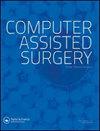Optimal definitions for computing HKA angle in caos: an in-vitro comparison study
IF 1.9
4区 医学
Q3 SURGERY
引用次数: 0
Abstract
Abstract The goal of this study was to assess and compare the precision and accuracy of nine and seven methods usually used in Computer Assisted Orthopedic Surgery (CAOS) to estimate respectively the Knee Center (KC) and the Frontal Plane (FP) for the determination of the HKA angle (HKAA). An in-vitro experiment has been realized on thirteen cadaveric lower limbs. A CAOS software application was developed and allowed the computation of the HKAA according to these nine KC and seven FP methods. The precision and the accuracy of the HKAA measurements were measured. The HKAA precision was highest when the FP is determined using the helical method. The HKAA accuracy was highest using the helical approach to determine the FP and either the notch or the tibial spines to determine the KC. This study shows that the helical approach to determine the FP and either the notch or the middle of tibia spines are the combinations that provide both a good enough accuracy and precision to estimate the HKA.计算caos中HKA角的最佳定义:体外比较研究
摘要本研究的目的是评估和比较计算机辅助骨科手术(CAOS)中常用的九种和七种方法的精度和准确性,分别估计膝关节中心(KC)和额平面(FP),以确定HKA角(HKAA)。在13具尸体下肢上进行了体外实验。开发了一个CAOS软件应用程序,允许根据这九种KC和七种FP方法计算HKAA。测量了HKAA测量的精度和准确性。当使用螺旋法测定FP时,HKAA的精度最高。使用螺旋入路确定FP,使用切口或胫骨棘确定KC,HKAA的准确度最高。这项研究表明,确定FP的螺旋方法和胫骨棘的凹口或中间是提供足够好的准确性和精度来估计HKA的组合。
本文章由计算机程序翻译,如有差异,请以英文原文为准。
求助全文
约1分钟内获得全文
求助全文
来源期刊

Computer Assisted Surgery
Medicine-Surgery
CiteScore
2.30
自引率
0.00%
发文量
13
审稿时长
10 weeks
期刊介绍:
omputer Assisted Surgery aims to improve patient care by advancing the utilization of computers during treatment; to evaluate the benefits and risks associated with the integration of advanced digital technologies into surgical practice; to disseminate clinical and basic research relevant to stereotactic surgery, minimal access surgery, endoscopy, and surgical robotics; to encourage interdisciplinary collaboration between engineers and physicians in developing new concepts and applications; to educate clinicians about the principles and techniques of computer assisted surgery and therapeutics; and to serve the international scientific community as a medium for the transfer of new information relating to theory, research, and practice in biomedical imaging and the surgical specialties.
The scope of Computer Assisted Surgery encompasses all fields within surgery, as well as biomedical imaging and instrumentation, and digital technology employed as an adjunct to imaging in diagnosis, therapeutics, and surgery. Topics featured include frameless as well as conventional stereotactic procedures, surgery guided by intraoperative ultrasound or magnetic resonance imaging, image guided focused irradiation, robotic surgery, and any therapeutic interventions performed with the use of digital imaging technology.
 求助内容:
求助内容: 应助结果提醒方式:
应助结果提醒方式:


